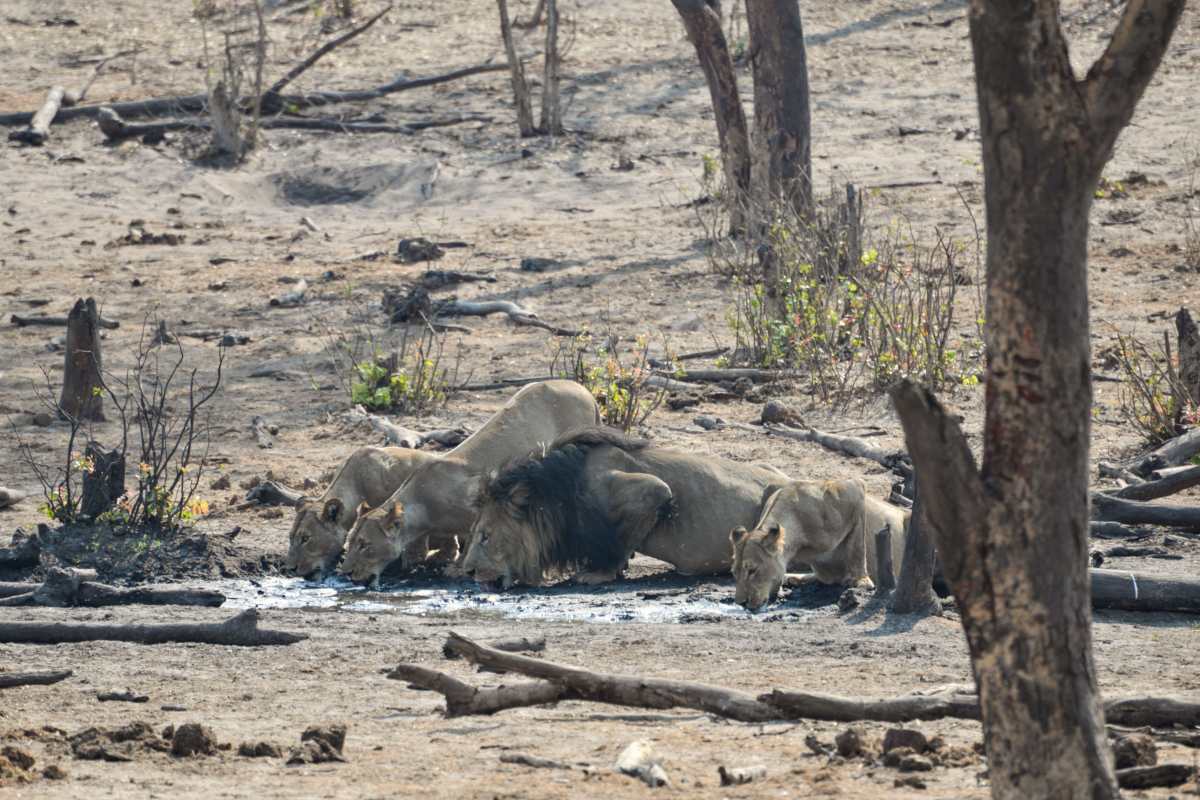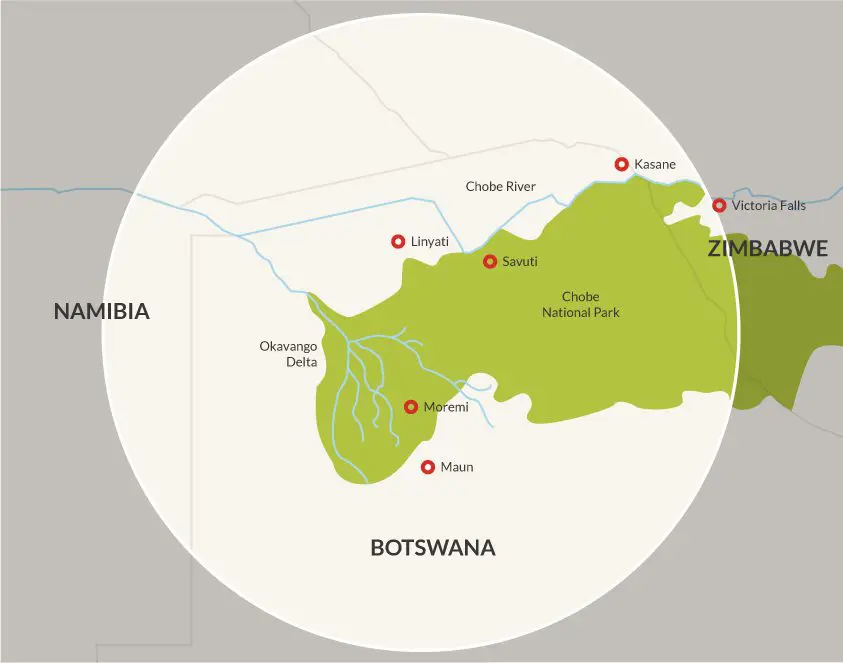Language
- Deutsch
- English
- Español
- Français
- Italiano
- Nederlands
- Português
Currency
- AUD Australian Dollar
- CAD Canadian Dollar
- EUR Euro
- GBP Pound Sterling
- SGD Singapore Dollar
- USD US Dollar
- ZAR Rand

If you want to see as many wild African elephants as possible – like herds of epic proportions – it's seriously tough to beat Chobe at the end of Botswana's dry season. The rainless winter begins in May and, by September and October, Chobe National Park is completely parched, driving gigantic concentrations of animals (especially elephant and buffalo) to the Chobe River.
Naturally the large predators follow suit, like prides of hungry lions looking for any opportunity to kill. This makes for sensational up-close photography, particularly on boating safaris amid snoozing hippos and titanic crocs. The Chobe River undeniably provides the stage for some of the best boat-based game viewing on the planet.

Chobe National Park lies in the northern part of Botswana and is about the size of Northern Ireland. It stretches along the magnificent Chobe River, which forms Botswana's natural border with Namibia. Habitats found within the park range from floodplains, woodlands and baobab trees to lush flood grasslands and thickets along the river.

The popular Chobe riverfront or Serondela area consists of lush floodplains and dense forests that attract colossal numbers of elephant and buffalo. It's also a vital watering spot for the majority of the park's wildlife, including the rare puku antelope. It's about 100 kilometres or 62 miles from Victoria Falls, which makes day trips to the world's biggest waterfall a breeze.

‘Because Chobe is a national park, it can get very busy during peak safari season, especially from July to October. I'd suggest staying at Chobe Game Lodge – it's the only safari lodge situated in the park, which means that you'll have about an hour's head start over the crowds during morning game drives.' – Lee-Anne Kock
Situated in the mid-west of the park and usually accessed by light aircraft, the Savuti Marsh area is considered by many safari aficionados as Botswana's ‘predator capital'. This mysterious, off-the-beaten-track region is fed by the ephemeral Savuti Channel and is made up of rich grasslands, savannah woodland and hundreds of spectral dead trees along the channel's bank. This is where large lion prides regularly clash with hyena clans for food and territory, and mighty lions take down Africa's biggest beasts like buffalo and even elephant. These epic battles have been well-documented in numerous wildlife documentaries. The Savuti lions are often extremely muscular, well-developed and powerful because they often hunt in the water and thick mud of the marsh.
Adjoining the western part of Chobe, wedged between the Okavango Delta and Namibia's Caprivi, the remote Linyanti Wildlife Reserve's marshes and dry woodlands provide a haven for big concentrations of game – especially elephant and buffalo. The Linyanti River and its spreading floodplains offer some of the best birdwatching in Southern Africa, harbouring many rarities (African skimmers, narina trogons and slaty egrets) and majestic birds of prey (Verreaux's eagles, little banded and gabor goshawks, and African eagle-hawks).

‘If you're looking for a land- and water-based safari away from the peak-season crowds, consider the private reserves and concessions like Linyanti, Kwando or Selinda. They also offer a more exclusive experience and activities that are not permitted in Chobe National Park, like nature walks and night game drives.' – Liesel van Zyl
Most safari-goers visit Chobe National Park during its dry season (about May to October). This is when ever-increasing numbers of water-dependent animals like elephant, buffalo and predators amass along the Chobe River and in the Savuti region. From about August to October it's bone-dry and very hot in Chobe, but if you can handle the heat, you'll be rewarded with Planet Earth's crème de la crème of game-viewing.
| PEAK SAFARI SEASON | LOW / GREEN SEASON | ||||
|---|---|---|---|---|---|
| When | Winter: about May to October | Summer: about November to April | |||
| Weather | May to July is dry with cold nights, but temperatures rise rapidly from about August to October. | Warm with afternoon thunderstorms. | |||
| Highlights |
|
|
|||
| Rates | High | Low |
It's not easy to give exact costs for any safari. At Go2Africa, we prefer tailor-making an itinerary that makes sense for your specific travel needs – hence no safari is ever the same. Some of the variables that can influence your safari budget are:
The following Chobe safari costs are guidelines only and based on a price-per-person-per-night, including accommodation and transfers:
| 4-STAR COMFORT | 4-STAR LUXURY | 5-STAR LUXURY | |||
|---|---|---|---|---|---|
| Low | High | Low | High | Low | High |
| $700 | $900 | $1,250 | $1,450 | $2,000 | $3,500 |
The more budget you have available, the more private and exclusive you can go on safari. The biggest benefit of staying in a private concession – other than personalised service and luxurious accommodation – is the quality of game viewing on offer (not of the wildlife but of the actual experience). Chobe National Park can get extremely busy during peak safari season (about July to October) and most of the time you'll share animal sightings with other vehicles and groups, including self-drivers and day-trippers. A private safari offers you a private guide, vehicle and an exclusive-use slice of pristine wilderness to traverse.
Connect with one of our Africa Safari Experts to help you plan a Chobe safari itinerary:
Kasane International Airport is less than a 10-minute drive from Chobe National Park's gate – unless you see game along the way! It connects easily with Johannesburg via daily flights, which in turn connects the rest of the African continent. A 2-hour road transfer will get you from Kasane to Victoria Falls, where you can encounter the world's biggest waterfall and catch a connecting flight from Victoria Falls Airport.
| DESTINATION | WHY GO | ||
|---|---|---|---|
| Okavango Delta |
|
||
| Central Kalahari |
|
||
| Victoria Falls |
|
||
| Zimbabwe |
|
||
| Zambia |
|
||
| Kruger |
|
||
| Cape Town |
|
Because Chobe is such an easy add-on to any Southern African safari itinerary, it's a great destination for first-time visitors to Africa and seasoned safari aficionados will love Savuti's dramatic game viewing. Chobe is also great for wildlife enthusiasts and avid wildlife photographers. We also recommend Chobe for families travelling with children over 12 years old.
Botswana is a safe destination to visit and we've been helping travellers discover the magical Chobe National Park since 1998.
Vaccination requirements may vary from country to country and we always recommend consulting your local travel clinic or GP for up-to-date information. Chobe falls in Southern Africa's malaria belt and prophylaxis is recommended – especially if you travel during the wetter months (November to April) and planning cultural tours to rural villages.